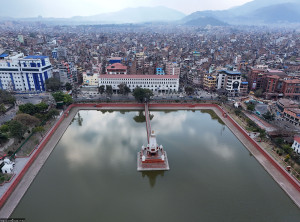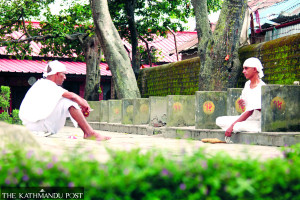Madhesh Province
Outmigration and declining participation threaten a Mithila tradition
Sama Chakeva is a ten-day festival celebrating sibling bond to ward off evil.
Aarati Ray
Since Kharna, the second day of Chhath on November 6, 85-year-old Kalia Devi Mandal has stepped out each evening with a ‘changeri’—a bamboo basket—balanced on her head. Inside are colourful clay idols of Sama, Chakeva, and Chugla.
As dusk falls, Mandal heads toward a nearby pond in her village of Khariyani, Janakpur, where a group of about fourteen girls and women, mostly old, wait to join her.
Together, these women move through the village, stopping at roadsides, ponds, riverbanks, and temples to sing and dance to Maithili folk songs in celebration of ‘Sama Chakeva’.
Though often overshadowed by sibling festivals like Bhai Tika and Rakhi (Rakshya Bandhan), Sama Chakeva is a ten-day ancient Hindu festival celebrated mainly in the Mithila region, which straddles Nepal and India.
Sama Chakeva, a festival celebrating sibling bonds, is slowly fading as urbanisation and migration take their toll. With fewer young people participating, the tradition’s rich rituals and songs are at risk of being lost.
Mandal recalls celebrating Sama Chakeva since she was just ten years old. “I remember my mother playing Sama Chakeva when I was little. I started joining her after my brother was born.”
For Mandal, the festival has always been an occasion to wish for the longevity of her brothers. The tradition, she explains, starts on Panchami (the fifth day of the lunar month) usually on Kharna and continues for ten days, culminating on the full moon night.
Another woman from the group, 65-year-old Laxmi Devi Paswan, says, “Many people in urban areas or from the younger generation may not know this, but the festival has ancient roots in the Puranas.”
According to folklore, the festival commemorates Lord Krishna’s daughter, Sama, and her brother, Samba (known as Chakeva), who was falsely accused of being romantically involved with an unnamed lover in the forest.
Believing the accusations, Krishna cursed his daughter to become a bird. Heartbroken, her brother prayed to Lord Vishnu, who granted him the power to transform into a bird to search for his sister. Chakeva finally recognised Sama through her song, and after many trials, the siblings were restored to their human forms.
The festival thus is a reminder of sibling loyalty and devotion. “We celebrate this festival believing in the power of sibling bonds to overcome evil,” says Paswan.
This festival is centred on women. In November, they prepare clay idols that represent figures from the mythological tale. The idols include Sama, Chakeva, and Chugla (the person who defamed Sama and symbolically those who engage in gossip or slander).
According to Mandal, the idols are crafted on Kharna day using mud from riverbanks and paddy fields. Once dried in the sun, they are coated with rice flour and painted with natural colours.
On the full moon night, girls and women feed ‘chyura dahi’ (curd and beaten rice) to their brothers and play with the idols under the moonlight, singing folk songs. After burning the moustache of Chugla as a symbol of defeating evil, the brothers carry the idols on a ‘doli’ (palanquin) for immersion in a river or water body on the last day.
However, the Sama Chakeva tradition seems to be fading, primarily due to the rise of nuclear families and the mass migration from the Madhesh region for employment.
“The groups playing Sama Chakeva used to be so large. Now, each year it is getting smaller,” Mandal says. Although the older generation like her remains committed to Sama Chakeva, fewer young people participate.
According to villagers, the sounds of ‘Sama Chakeva’ songs are becoming rarer these days. “In the past, folk songs could be heard in every corner of the village. But now, the old atmosphere is no longer there.”
In years past, the tradition of making clay idols was an important communal activity. Women would gather mud from riverbanks and paddy fields on Kharna, then dry and decorate the idols with natural colours. This practice celebrated the connection between the festival and Maithili art and sculpture.
However, even this tradition is changing. “Nowadays, many people buy ready-made idols from the market,” says 41-year-old Sita Mishra from Janakpur. “Although this supports local potters, it’s disheartening to know that the joy of gathering mud together and making idols by hand, singing folk songs all the while, is fading.”
Mishra’s younger daughter still participates in Sama Chakeva in Janakpur, but her older daughter, now working in Dharan, has stopped. Instead, she celebrates Bhai Tika with her friends, which she feels similarly honours sibling love. “My daughter says both festivals are about sibling bonds,” says Mishra. “But what about preserving the Maithili culture and tradition?”
The challenge is perhaps most strongly felt by those who have migrated from rural villages to cities. Paswan’s granddaughter, Simran, who now lives in Kathmandu, says, “When we first moved here, my mother and I tried to celebrate Sama Chakeva for a couple of years, even if it was just the two of us.”
But they eventually stopped due to the lack of community and the unfamiliarity of Sama Chakeva among urban dwellers. “Sama Chakeva is played in a group. When we went out alone carrying a ‘changeri’ with small clay idols, people called us weird saying we were practising black magic,” Simran adds. “So we stopped.”
Despite the festival’s struggles, some have taken steps to keep Sama Chakeva alive in new settings.
Ragni Chaudhary, 36, originally from Sarlahi, began celebrating Sama Chakeva in her new home of Itahari, Sunsari, in 2022. “For a few years, I didn’t celebrate it, thinking where would I find people who celebrate Sama Chakeva and what if others found it strange?” she says.
But seeing the enthusiasm around Bhai Tika encouraged her to reconnect with her roots. “Everybody has their own culture. If we don’t respect it ourselves, who will?”
In her first year in Itahari, Chaudhary gathered just three other friends. But the group has now grown to twelve girls and women.
To Chaudhary, the festival is also about preserving the connection between culture and nature.
Sama Chakeva coincides with the migration of Himalayan birds to the plains in winter, and the clay idols are fashioned in the shapes of birds as a tribute to the migratory flyers.
The final ritual, in which the idols are immersed in a river on the tenth day, is both a farewell and a call to the birds to return the following year. “By using clay and natural colours to make idols, we honour the earth,” Chaudhary says.
Yet, the festival’s decline is undeniable, and for many, the fear of losing Maithili cultural heritage grows stronger each year.
Paswan remembers her granddaughter, once praised as the best singer of Sama Chakeva songs in their village. But when she visited during Chhath last year, she had forgotten the song.
“She can’t sing it anymore...Sama Chakeva songs carry Maithili tradition, art and essence. The younger generation is losing touch with their identity,” says Paswan.
As families continue to fragment and younger generations grow up in urban areas, traditional festivals face new challenges.
But for those who still gather under the November moon, the festival is a reminder of a heritage worth preserving.
“Our culture has always been connected to nature. Sama Chakeva celebrates this connection, and I hope we can pass it on to the younger generations. We are its last guardians; if we don’t keep it alive, it will be lost forever,” says Chaudhary.




 21.1°C Kathmandu
21.1°C Kathmandu











